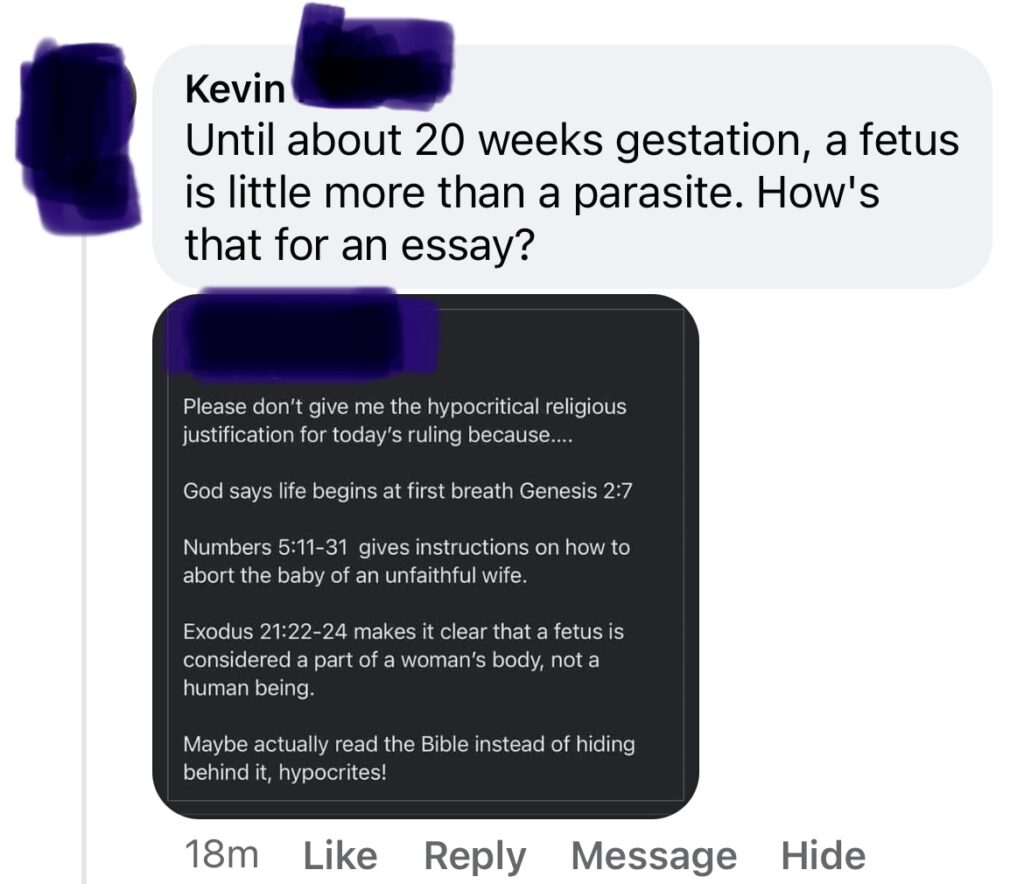By Susan Ciancio
For the first time in three years, the Culture of Life Studies Program is hosting its annual Pro-Life Essay Contest. This is a vital tool in helping young people articulate their pro-life beliefs and learn to stand up for the most vulnerable among us. We are beyond thrilled to read the thoughtful essays submitted by kids in middle and high school, and we have worked hard to get the word out to as many kids as possible.
Yet just this past weekend, a man named Kevin illustrated perfectly one of the many reasons our young people need to hone their writing and speaking skills regarding pro-life topics.
In response to a FB post about CLSP’s Pro-Life Essay Contest, Kevin wrote: “Until about 20 weeks gestation, a fetus is little more than a parasite. How’s that for an essay?” He then included a screenshot of someone else’s interpretation of a few Bible verses (see below for image):

Apparently this poster is asserting that the Bible condones the killing of preborn babies. It does not. Nor does the Catholic Church.
But let’s look at the Bible verses she referenced and misinterpreted.
Genesis 2:7 does not say that life begins at first breath. That verse is actually about the creation of Adam, and it says: “Then the Lord God formed the man out of the dust of the ground and blew into his nostrils the breath of life, and the man became a living being.”
Numbers 5:11-31 does not give instructions on how to abort a baby. Quite the opposite, actually. This section deals with what is called an “ordeal for suspected adultery,” and it addresses a situation in which a man suspects his wife of being unfaithful. Here, we need to understand a bit of background to understand this new law. God is teaching the Jewish people a valuable lesson about how to treat others. Prior to God revealing His laws, men did whatever they wanted with women because they were considered property. And often they were treated poorly. But God’s laws were meant to bring about a new way of living. As we know, whenever something new is taught, it must be taught in stages. God knew that well. He had to make people understand simple rules before they could understand more complicated ones. This is one of those instances.
So now with God’s laws, a man cannot just harm his wife if he suspects her of adultery. He must take her before a mediator, who performs a ritual that is supposed to determine her infidelity but that, in reality, will not hurt her. During this ritual—or ordeal—the mediator adds a cereal offering (some kind of grain) to water. This is harmless to anyone who drinks it. But if the woman is guilty, something has to happen to “miraculously” change the substance.
Is this going to happen? Not likely. This appeal to mediation was one of the very first steps in teaching men that they cannot use power over women to hurt them. This is actually a way to protect women.
Finally, Exodus 21:22 says, “When men have a fight and hurt a pregnant woman, so that she suffers a miscarriage, but no further injury, the guilty one shall be fined as much as the woman’s husband demands of him, and he shall pay in the presence of the judges.”
The lines after this talk about an eye for an eye and about revenge in addition to punishment for intentional versus unintentional death. Nowhere does it say that a fetus is not a human being.
The poster admonishes people to “actually read the Bible,” and I have done that cover to cover. More than once. Instead of the nefarious interpretation she assigns, I see a God who loves His people, who values life, and who charges us to protect our fellow human beings.
This is evident in verses like these:
- “You shall not kill.”
- “Before I formed you in the womb I knew you, before you were born I dedicated you, a prophet to the nations I appointed you.”
- “Thus says the Lord, your redeemer, who formed you from the womb: ‘I am the Lord, who made all things.’”
- “You formed my inmost being; you knit me in my mother’s womb.”
Christ teaches peace, kindness, and an adherence to the Commandments. He would never advocate for the intentional killing of one of His precious children—a human being made in His image and likeness.
And yes, preborn babies are human beings from the first moment of creation. The science of embryologyteaches us that when it says: “Carnegie Stage 1 represents FERTILIZATION and is divided into three substages; a, b and c, and is the unicellular embryo that contains unique genetic material and is a single-cell HUMAN BEING that develops into all of the subsequent stages of a human being.” (emphasis in original)
A human being is created the very moment the sperm fertilizes the egg. In fact, all the DNA the person has is present from that moment forward.
This preborn child is not part of his mother’s body like an arm or a vital organ. He resides within her body because he needs her to care for him.
We all have needed or will need the help of others. Nobody lives in this world alone.
A newborn needs a mother and father to take care of him.
An elderly person in a nursing home needs someone to take care of him.
A person confined to bed or to a wheelchair needs someone to help care for him.
In fact, even a perfectly healthy person needs someone to help take care of him, as no one is truly independent. That healthy person must have a job in order to get the paycheck that pays for his food and shelter. He must rely on someone to stock his grocery store with food. He depends on someone at the electric company to make sure the power stays on. The list is endless.
Are any of these people parasites because they need the help of others? No. And neither is the preborn baby.
We are all human beings in various stages of life, and it is up to all of us to protect the vulnerable. We do this out of compassion. We do this out of love. And we do this because anything less would be barbaric.
Let us teach our children to care for others, and let us help them articulate why we should care for others. Then, when confronted by the Kevins of this world, they will know how to respond.
To learn more about the CLSP Pro-Life Essay Contest, or to enter, visit prolifeessay.com.
